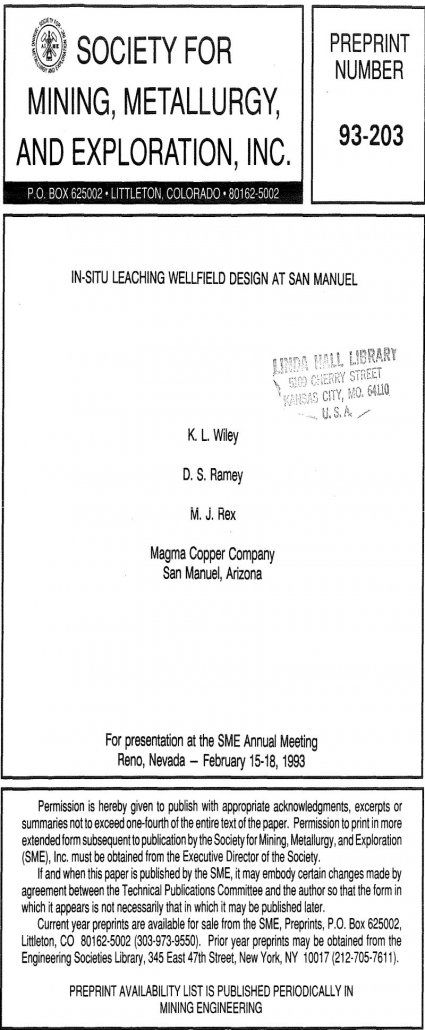Thiosulfate Leaching of Gold from Copper Bearing Ores

Cyanide has been used in the mining industry for gold and silver recovery for almost a century. It is cost-effective and achieves excellent extractions from a wide range of ores. However, considerable interest has been expressed in non-cyanide lixiviants since the early 1980’s. In addition to environmental considerations, several factors have influenced the search for […]
Recover Manganese from Bioleaching Solution

Diminishing worldwide reserves of high-grade ores requires research be conducted to develop methods to recover metals from low-grade ores. Low-grade ore deposits are often unprofitable to mine and process because of the rising costs of energy and expense to protect our environment. Biological processing can be quite selective, is environmentally benign, and has the potential […]
Control of Copper in Carbon Gold Recovery Circuits

The American Girl Mining Joint Venture is an equal partnership between Eastmaque Gold Mines, Ltd. of Vancouver, BC Canada and MK Gold Company, a wholly owned subsidiary of Morrison Knudsen Corporation of Boise, Idaho. Underground mining and open pit methods are used to supply ore to the processing areas. Heap leaching of ore grades in […]
In-Situ Resource Recovery Testing

In-Situ mining at San Manuel, initiated in 1986, has evolved from a system utilizing an underground collection gallery to recover gravity drainage pregnant leach solution to a system primarily utilizing well-to-well leaching and recovery. This shift in production methodology began in 1989 after a study of the feasibility of well-to-well leaching. This study led to […]
In-Situ Leaching

The in-situ leaching project at San Manuel was initially designed to utilize gravity flow leaching to recover oxidised copper from partially rubblized and supergene mineralized rock that was spatially situated adjacent to an abandoned portion of the block cave underground mine. During the construction of this in-situ leaching system, an underground drainage gallery collection facility […]
Acid Alcohol Leaching of Apatite

The current practice for the production of wet-process phosphoric acid (H3PO4) involves leaching beneficiated phosphate rock in the presence of aqueous sulfuric acid (H2SO4). Typical processing involves mining the ore and beneficiating through sizing and flotation to produce a “phosphate rock” concentrate containing over 29 pct P2O5. This concentrate is ground to 90 pct minus […]
Low Temperature Pressure Oxidation

Aqueous pressure oxidation at low temperature, although desirable from a process engineering and operations point of view, presents unique problems when temperatures approach 160°C (320°F). In developing the pressure oxidation process for the Lone Tree Mine, elemental sulfur formation and agglomeration with pyrite proved to be a problem. The Lone Tree Mine currently operates a […]
Refractory Gold Ore Flash Roasting

Roasting of refractory gold ores has the primary goal of oxidizing sulfides and organics to improve gold recoveries prior to leaching. Commercial installations currently utilize bubbling and circulating fluidized beds. The principle of flash roasting is aimed at a more cost effective method of whole ore roasting for large throughput applications. Results of pilot plant […]
Testing Refractory Gold Ore

Gold in primary deposits is generally recovered by dissolution in dilute cyanide solution followed by recovery from solution using zinc cementation or carbon adsorption. The dissolution step can be conducted in heaps, vats, or agitated tanks. Gravity concentration, or an intermediate flotation step is an additional process at some operations. An analysis of the processing […]
Pressure Oxidation Treatment

Since start-up in 1985 the Cannon Mine has produced and shipped a 170 g Au/tonne (5 oz Au/ton) flotation concentrate to various smelters for gold and silver recovery. Several processes have been investigated to economically produce dore’ at the mine site from the refractory concentrate. The designed pressure oxidation circuit utilizes a series of vertical […]
